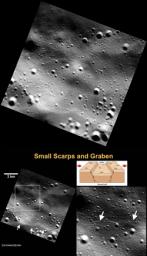Small graben, narrow linear troughs, have been found associated with small scarps (bottom left, white arrows) on Mercury and the Moon. These graben (bottom right, white arrows) likely resulted from the bending and extension of the upper crust in response to scarp formation (bottom illustration) and are only tens of meters wide. On the basis of the rate of degradation and infilling of small troughs on the Moon by continuous meteoroid bombardment, small lunar graben and their associated scarps are less than 50 Myr old! It is likely that Mercury's small graben and their associated scarps are younger still, because the cratering rate on Mercury is greater than on the Moon.
This image was discussed at a press event on Monday at the Lunar and Planetary Science Conference. Visit the press event website to learn more!
This image was acquired as part of the MDIS low-altitude imaging campaign. During MESSENGER's second extended mission, the spacecraft makes a progressively closer approach to Mercury's surface than at any previous point in the mission, enabling the acquisition of high-spatial-resolution data. For spacecraft altitudes below 350 kilometers, NAC images are acquired with pixel scales ranging from 20 meters to as little as 2 meters.
Date acquired: June 30, 2014
Image Mission Elapsed Time (MET): 46425834
Image ID: 6594219
Instrument: Narrow Angle Camera (NAC) of the Mercury Dual Imaging System (MDIS)
Center Latitude: 77.22°
Center Longitude: 63.96° E
Resolution: 16 meters/pixel
Scale: 2 km (1.2 miles) scale bar on image
Incidence Angle: 78.0°
Emission Angle: 0.1°
Phase Angle: 78.1°
The MESSENGER spacecraft is the first ever to orbit the planet Mercury, and the spacecraft's seven scientific instruments and radio science investigation are unraveling the history and evolution of the Solar System's innermost planet. During the first two years of orbital operations, MESSENGER acquired over 150,000 images and extensive other data sets. MESSENGER is capable of continuing orbital operations until early 2015.
For information regarding the use of images, see the MESSENGER image use policy.

 Planetary Data System
Planetary Data System












